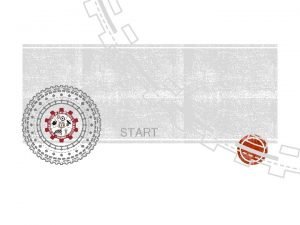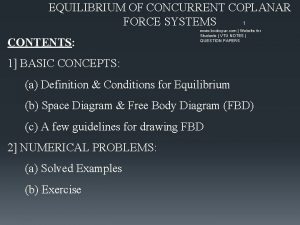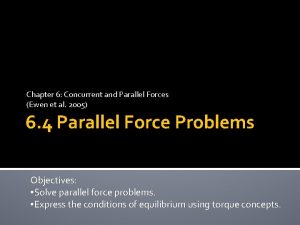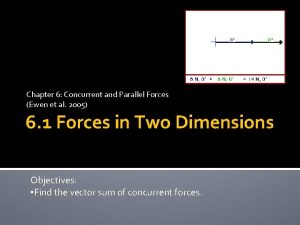Chapter 6 Concurrent and Parallel Forces Ewen et









- Slides: 9

Chapter 6: Concurrent and Parallel Forces (Ewen et al. 2005) 6. 2 Concurret Forces in Equilibrium Objectives: • Analyze equilibrium in one dimension. • Analyze concurrent forces using force diagrams. • Distinguish between compression and tension.

Equilibrium in One Dimension �Equilibrium is a state of a body in which there is no change in its motion. Object is not accelerating, either at rest or moving at a constant velocity. Net force is zero (Fnet = SF = 0) �The study of objects in equilibrium is called statics.

Example 1 �A cable supports a large crate of weight 1250 N. What is the upward force on the crate if it is in equilibrium?

Example 2 �Four persons are having a tug-of-war with a rope. Harry and Maria are on the left. And Juan and Jill are on the right. Maria pulls with 105 lb, Harry pulls with 255 lb, and Jill with 165 lb. With what force must bill pill to produce equilibrium?

Equilibrium in Two Dimensions �When two or more forces act at a point, the equilibrant force is the force that when applied at the same point produce equilibrium. �In two dimensions, for an object to be in equilibrium, the sum of BOTH the x- and ycomponents must be equal to zero.

�Tension – stretching force produced by forces pulling outwards on the ends of an object. �Compression – force produced by forces pushing inward on the ends of an object.

Example 3 �Two cables supports a crate. The first cable is positioned at a angle of 00 relative to the crate. The second cable is at an angle of 120 o and has a tension of 375 lb. Find the tension on the first cable and the weight of the crate is in equilibrium.

Example 4 �A homeowner pushes a 40. 0 lb lawn mower at a constant velocity. The frictional force on the mower is 20. 0 lb. What force must the person exert on the handle, which makes an angle of 30. 0 o with the ground? Also, find the normal force.

Example 5 �The crane is supporting a crate weighing 6. 00 E 3 N. Find the tension in the horizontal supporting cable and the compression on the boom. Assume the crate is in equilibrium.

















